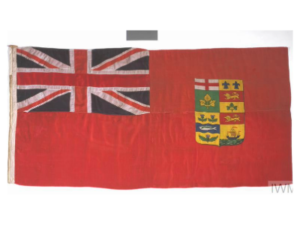FLYING PROUD: THE MAPLE LEAF FOREVER
What is red and white and blows in the wind? That’s not the opening of a joke: the answer is Canada’s national flag, the Maple Leaf. While most Canadians will pass at least one Maple Leaf each day, how many know how it came to be? On 15 February 2025, the Maple Leaf turns sixty years old – as good a time as any to tell its origin story.
During Canada’s pre-Confederation period, flags of Europe were used to denote territorial claims: France’s Fleur-de-Lys pre-1759, and Britain’s Royal Union Flag post-1759. About 1870, Canada began using a version of the Red Ensign – the British Merchant Marine flag with the original four provinces’ coats-of-arms on one shield – as its national flag.
Britain’s flag was still commonly used on land, and in 1904 it replaced the Ensign as the flag on Parliament Hill’s Peace Tower. Canadian troops in the First World War fought under the British flag, but under the Canadian Red Ensign in the Second. In 1945, the Ensign once again flew on all Canadian federal government buildings.
 Canada’s “Great Flag Debate” began in 1960, when Lester Pearson raised in the House of Commons the issue of a national flag. Extensive discussion brought about no results. In 1964, now Prime Minister Pearson presented a design to Parliament: a sprig of 3 red maple leaves on white, with two flanking vertical blue bars. The “Pearson Pennant” was not accepted, so an all-party committee was established; in 6 weeks, it reviewed nearly 6,000 submitted designs and unanimously decided on the red and white, single leaf design of today. After another 6 weeks of parliamentary debate, involving 308 speeches, the committee’s recommendation was accepted (163-78) on 15 December 1964; two days later the Senate approved it. Queen Elizabeth signed the royal proclamation on 28 January 1965, and Canada had its new flag. On 15 February 1965 (now Flag Day annually), the Canadian Red Ensign was taken down from Parliament Hill and the Maple Leaf was raised officially for the first time.
Canada’s “Great Flag Debate” began in 1960, when Lester Pearson raised in the House of Commons the issue of a national flag. Extensive discussion brought about no results. In 1964, now Prime Minister Pearson presented a design to Parliament: a sprig of 3 red maple leaves on white, with two flanking vertical blue bars. The “Pearson Pennant” was not accepted, so an all-party committee was established; in 6 weeks, it reviewed nearly 6,000 submitted designs and unanimously decided on the red and white, single leaf design of today. After another 6 weeks of parliamentary debate, involving 308 speeches, the committee’s recommendation was accepted (163-78) on 15 December 1964; two days later the Senate approved it. Queen Elizabeth signed the royal proclamation on 28 January 1965, and Canada had its new flag. On 15 February 1965 (now Flag Day annually), the Canadian Red Ensign was taken down from Parliament Hill and the Maple Leaf was raised officially for the first time.
That last Parliament Hill Red Ensign is now part of the Peterborough Museum & Archives’ holdings.
By: Don Willcock,
The Peterborough Museum & Archives,
300 Hunter St E, Peterborough 705-743-5180




